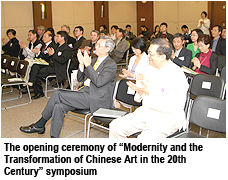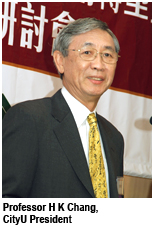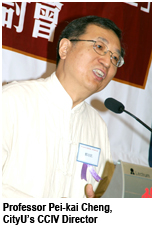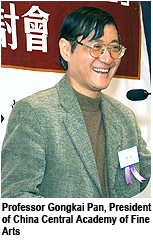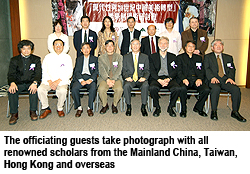CityU hosts international symposium on modernity and Chinese art
Jenny Kwan
The symposium entitled "Modernity and the transformation of Chinese art in the 20th century" and the exhibition “The road of Chinese modern art” were co-organized by Chinese Civilisation Centre (CCIV) at CityU and China Central Academy of Fine Arts (CCAFA).
The purpose of the symposium, which ran from 29 April to 1May, was for renowned scholars from mainland China, Taiwan, Hong Kong and overseas to discuss the relationship between modernity, art, history and culture in China.
Professor H K Chang, CityU President, Professor Pan Gongkai, CCAFA President and Professor Cheng Peikai, CCIV Director, presided over the opening ceremony. In his opening speech, Professor Chang raised important questions about modernity.
"We should try to comprehend modernity through different approaches and acknowledge that modernity is changing constantly," Professor Chang said.
He highlighted the necessity of discussing the concepts of 'discipline', i.e. an academic subject, and 'modernity', and said a person who knew how to appreciate the beauty of art often possessed a creative and swift mind and led a meaningful life.
"Advanced societies hope to boost economic growth by capitalizing on creativity, concepts and products," Professor Chang said.
In his speech, Professor Cheng said by understanding culture we value art. "I believe a symposium like this is a rare opportunity to appreciate and experience history and culture," he said, adding that it was a great honour to co-organize the symposium with CCAFA.
Professor Pan said he had been researching Chinese modern art since 1999, evaluating its impact from 1840 onwards and reflecting on modernity-related issues and theories of modernity in China.
Topics covered at the symposium included Chinese problematic; diversity and paradox of modernity; modernity and autonomy in Chinese intellectual life; and self-consciousness to the modern transformation: the Chinese experiences of modernity.
A roundtable discussion later focused on the validity of the discursive interpretation of modernity in China; modernity: original and successive; and self-consciousness in the modern transformation of China.
The participants were all the renowned scholars from mainland China, Taiwan, Hong Kong and overseas, including Professor Martin J Powers, Department of Art History, University of Michigan, US; Professor Gan Yang, research officer, Center of Asian Studies, University of Hong Kong; Professor Lee Ou Fan, Department of Cultural and Religious Studies, The Chinese University of Hong Kong; Professor Meng Yue, Department of Chinese, Tsinghua University; Professor (Honorary) Lin Yusheng, Department of History, The University of Wisconsin, Madison; Professor Jin Guantao, Director of Research Centre for Contemporary Chinese Culture, The Chinese University of Hong Kong; Professor Xia Zhujiu, Graduate Institute of Building and Planning, National Taiwan University; Professor Naoki Sakai, Department of East Asian Studies and Comparative Literature, Cornell University, US; Professor Gao Minglu, Department of History of Arts & Architecture, University of Pittsburgh, US; Professor Ge Zhaoguang, Department of History, Tsinghua University; Professor Chen Pingyuan, Department of Chinese, Beijing University; Professor Yang Nianqun, Renming University of China; Professor Zhang Longxi, Chair Professor of Department of Chinese, Translation and Linguistics and Director of Centre for Cross-Cultural
Studies, City University of Hong Kong; Professor Liu Xiaofeng, Department of Philosophy and Director of The Institute of Comparative Religion, Sun Yat-Sen University; Professor Deng Zhenglai, Center of Theoretical Legal Studies, Jinlin University; and Professor Terry Smith, Department of History of Arts & Architecture, University of Pittsburgh, US.
The exhibition entitled "The Road of Chinese Modern Art", which also ran from 29 April to 1 May, presented four strategic periods that emerged in the modern transformation of Chinese art between 1840 and 2000, namely traditionalism; syncretism; westernism; massificationalism. More than 2,000 pictures were on display.
A draft version of the book The Road of Chinese Modern Art by Professor Pan and others was presented at the exhibition.
